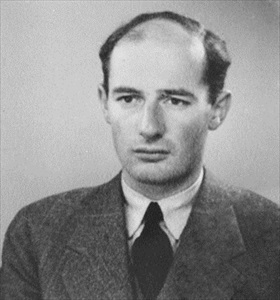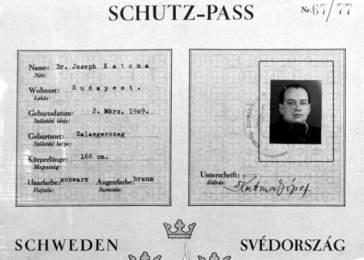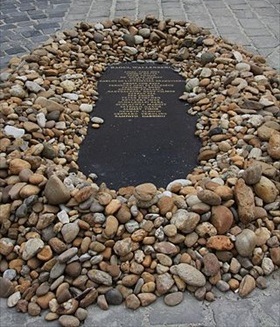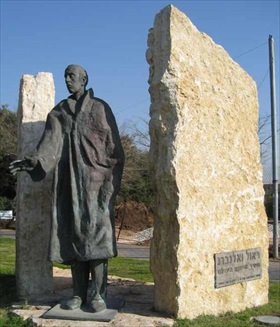RAUOL WALLENBERG TO RESCUE HUNGARY’S JEWS
Budapest, Occupied Hungary • July 9, 1944
On this date in 1944 Raoul Wallenberg, a 31-year-old bachelor from a distinguished Swedish family, arrived in Budapest, capital of Nazi-occupied Hungary. With diplomatic accreditation from the Swedish Ministry of Foreign Affairs (Sweden was a neutral nation), Wallenberg had been secretly recruited by the recently created (January 22, 1944) U.S. War Refugee Board to rescue Hungarian Jews by either transporting them out of Hungary or establishing havens of temporary refuge for them inside the country.
Wallenberg arrived in Hungary when deportations of Jews were well under way. In just 6 weeks in the summer of 1944 over 450,000 Hungarian Jews were fed into Auschwitz-Birkenau’s gas chambers and crematoria in Nazi-occupied Poland, and only an estimated 250,000 remained in the country, chiefly in the capital. Sweden’s special envoy immediately set about printing and distributing thousands of certificates of protection (Schutzpaesse in German; see example below) to as many of the survivors as he could find, thus preventing their deportation and inevitable murder. Using WRB and Swedish funds, Wallenberg rented over 30 buildings, thereby lending the buildings extraterritorial status protected by diplomatic immunity. Roughly 10,000 persons found shelter in these “safe houses.” At its height Wallenberg’s network employed 350 people, mainly Hungarians mixed with Swedes, a few diplomats from neutral Switzerland, Portugal, Spain, and the Vatican, and some anti-fascist Hungarians who liaised with Britain’s secret espionage organization, the Special Operations Executive.
Wallenberg’s action made him a special target of SS Obersturmbannfuerher (Lt. Col.) Adolf Eichmann. Head of the German Gestapo’s Section IVB for Jewish Affairs, Eichmann had arranged the infamous January 22, 1942, Wannsee Conference in a Berlin suburb, at which plans were hatched for the “final solution to the Jewish problem” in the German sphere of influence in Europe. The “final solution” was the Nazis’ euphemism for the extermination of European Jewry. The largest population of European Jews left intact were the 725,000 or so living in Hungary, 300,000 of whom were refugees from Nazi-controlled Europe. Eichmann’s task since crossing into Hungary on the heels of 11 Wehrmacht divisions on March 19, 1944, was to quickly round them up and deport every last one of them to what he called the “Auschwitz mill.”
The fearless Swede put his life on the line multiple times. Eichmann denounced Wallenberg’s “abuse of the safe conducts” the Swedish “Jew-lover” liberally distributed. One day early in November 1944 Wallenberg interceded with SS guards to save perhaps 200 Jews who held Swedish Schutzpaesse, slipping a few more to people when the guards weren’t looking. Most famously, on November 23, 1944, in Eichmann’s presence Wallenberg delayed the departure of a trainload of Jews stopped at the Hungarian-Austrian border, ignoring the fixed bayonets Arrow Cross (Hungarian Nazis) guards pointed at his chest, and handed out “replacement” Schutzpaesse to as many people on the platform as he could. In short order he had lined up 300 Jews, who clambered into cars and trucks in a convoy he led back to Budapest.
Accorded the honor of “Righteous Among the Nations” by Israel’s Yad Vashem as well as Israeli citizenship in 1986, Wallenberg—sometimes called the “Swedish Schindler”—is widely celebrated for saving tens of thousands of Hungary’s Jews. Oddly, Sweden’s government turned a blind eye and deaf ear after Wallenberg was reported taken into custody and placed in detention by Soviet intelligence operatives during the Red Army’s offensive against the Wehrmacht in January 1945. Seventy-one years after his disappearance, Sweden issued his death certificate after repeated requests by Wallenberg’s family.
Holocaust Hero Rauol Wallenberg, 1912–1947?
 |  |
Left: Swedish aristocrat, businessman, diplomat, and humanitarian Raoul Wallenberg (1912–1947?) is widely honored for his successful efforts to rescue tens of thousands to as many as one hundred thousand Jews from Hungarian Arrow Cross fascists and the Nazis in German-occupied Hungary during the later stages of the war. While serving in his official capacity as secretary to the Royal Swedish Embassy in Budapest between July and December 1944, Wallenberg, who was one-sixteenth Jewish, issued thousands of certificates of protection (Schutzpaesse), sometimes called protective passports. The blue-and-yellow certificates embossed with the three-crown royal emblem signified that the bearers were under the official protection of the Swedish Embassy and therefore could not be deported to death camps such as Auschwitz. (The Swiss embassy, too, had its own version of the Schutzpass). At the height of the Soviet siege of Budapest on January 17, 1945, Wallenberg disappeared during a visit to Red Army headquarters. He was later reported to have died in Moscow’s Lubyanka prison on July 17, 1947, while imprisoned by the Soviet secret police. The motives behind Wallenberg’s arrest, detention, and probable execution, along with questions surrounding his ties to the U.S. Office of Strategic Services (a wartime intelligence agency of the United States) and Hungary’s anti-fascist opposition, remain murky.
![]()
Right: Swedish Schutzpass issued to Rabbi József (Joseph) Katona, the Chief Rabbi of the Dohány Street Synagogue (Great Synagogue), dated Budapest, Hungary, September 15, 1944. Rabbi Katona survived the war along with more than 100,000 Hungarian Jews—mostly owing to the efforts of Wallenberg, his diplomatic colleagues, and hundreds of “protected Jews,” who together established sanctuaries, hospitals staffed by dozens of volunteer nurses and doctors, schools, nurseries, orphanages, and soup kitchens in a so-called “international ghetto” for Jews holding Swedish and other protective passes and forged documents.
 |  |
Left: Hungary named Wallenberg an honorary citizen in 2003. Several Hungarian sites honor him, including this one in the Raoul Wallenberg Memorial Park at the Dohány Street Synagogue in the center of Budapest. A joint secondary and vocational school located several miles/kilometers from the Dohány Street Synagogue is named after him.
![]()
Right: The statue of Raoul Wallenberg on Wallenberg St., Tel Aviv, Israel, is identical to the one in Budapest. At least 5 streets in Israel are named after Wallenberg. Israel granted Wallenberg honorary citizenship in 1986 and honored him, as it did German industrialist Oskar Schindler, at the Yad Vashem memorial in Jerusalem as one of the Righteous Among the Nations, a designation that recognizes Gentiles who saved Jews during the Holocaust (Shoah in Hebrew). The U.S. Congress made Wallenberg an Honorary Citizen of the United States in 1981, the second person after Winston Churchill to be so honored. The portion of the street on which the U.S. Holocaust Memorial Museum is located was renamed in his honor.
Tribute to Raoul Wallenberg
![]()

 History buffs, there is good news! The Daily Chronicles of World War II is now available as an ebook for $4.99 on Amazon.com. Containing a year’s worth of dated entries from this website, the ebook brings the story of this tumultuous era to life in a compelling, authoritative, and succinct manner. Featuring inventive navigation aids, the ebook enables readers to instantly move forward or backward by month and date to different dated entries. Simple and elegant! Click
History buffs, there is good news! The Daily Chronicles of World War II is now available as an ebook for $4.99 on Amazon.com. Containing a year’s worth of dated entries from this website, the ebook brings the story of this tumultuous era to life in a compelling, authoritative, and succinct manner. Featuring inventive navigation aids, the ebook enables readers to instantly move forward or backward by month and date to different dated entries. Simple and elegant! Click 











